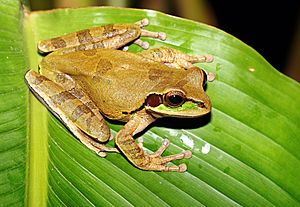New Granada cross-banded tree frog facts for kids
Quick facts for kids New Granada cross-banded tree frog |
|
|---|---|
 |
|
| Conservation status | |
| Scientific classification |
The masked tree frog (Smilisca phaeota) is a cool frog that lives mostly in the warm, wet forests of Central America and South America. It's also sometimes called the New Granada cross-banded tree frog. These frogs get their name because they look like they are wearing a black mask! This "mask" goes right over their eyes and helps them blend in, making it harder for other animals to spot them.
Contents
Meet the Masked Tree Frog
The masked tree frog is a type of frog that belongs to the Smilisca group. These frogs are known for living in trees and having special features that help them climb. They were first described by a scientist named Edward Drinker Cope in 1862.
Where Do They Live?
Masked tree frogs love tropical forests. You can find them in countries like Costa Rica, Panama, Colombia, and Ecuador. They prefer places with lots of trees and water, like rainforests and cloud forests. They often hang out near streams or ponds where they can find food and lay their eggs.
What Do They Look Like?
Besides their famous black mask, masked tree frogs have smooth, green or brownish skin. This helps them blend in with leaves and branches. They have big, round eyes that are often golden or bronze. Their toes have special sticky pads, which are perfect for climbing and holding onto slippery leaves and branches. These frogs are usually about 2 to 3 inches (5 to 7.5 cm) long, which is about the size of a small apple.
What Do Masked Tree Frogs Eat?
Masked tree frogs are carnivores, which means they eat other small animals. They mostly munch on insects like crickets, flies, and moths. They are nocturnal, meaning they are most active at night. This is when they hunt for their food, using their excellent eyesight to spot prey in the dark.
Life Cycle of a Frog
Like all frogs, masked tree frogs start their lives as eggs. The female frog lays her eggs in water, often in small ponds or slow-moving streams. These eggs hatch into tadpoles, which are tiny, fish-like creatures that live in the water. Tadpoles eat algae and other plant matter. As they grow, they slowly change, developing legs and losing their tails. This process is called metamorphosis. Eventually, they become tiny froglets, which then grow into adult masked tree frogs ready to live on land and in the trees.
Staying Safe: Hiding from Predators
The black mask on the masked tree frog isn't just for looks; it's a clever way to stay safe! This mask helps break up the outline of their face, making it harder for predators like snakes, birds, and larger animals to see them. Their green and brown skin also helps them blend in with their surroundings, acting like natural camouflage. When they feel threatened, they might freeze or try to jump away quickly.
Are They in Danger?
Good news! The masked tree frog is currently listed as "Least Concern" by conservation groups. This means they are not in immediate danger of disappearing. However, like many animals, their habitats are sometimes threatened by deforestation and pollution. Protecting their forest homes is important to make sure these cool masked frogs continue to thrive.
More Information
- In Spanish: Smilisca phaeota para niños




